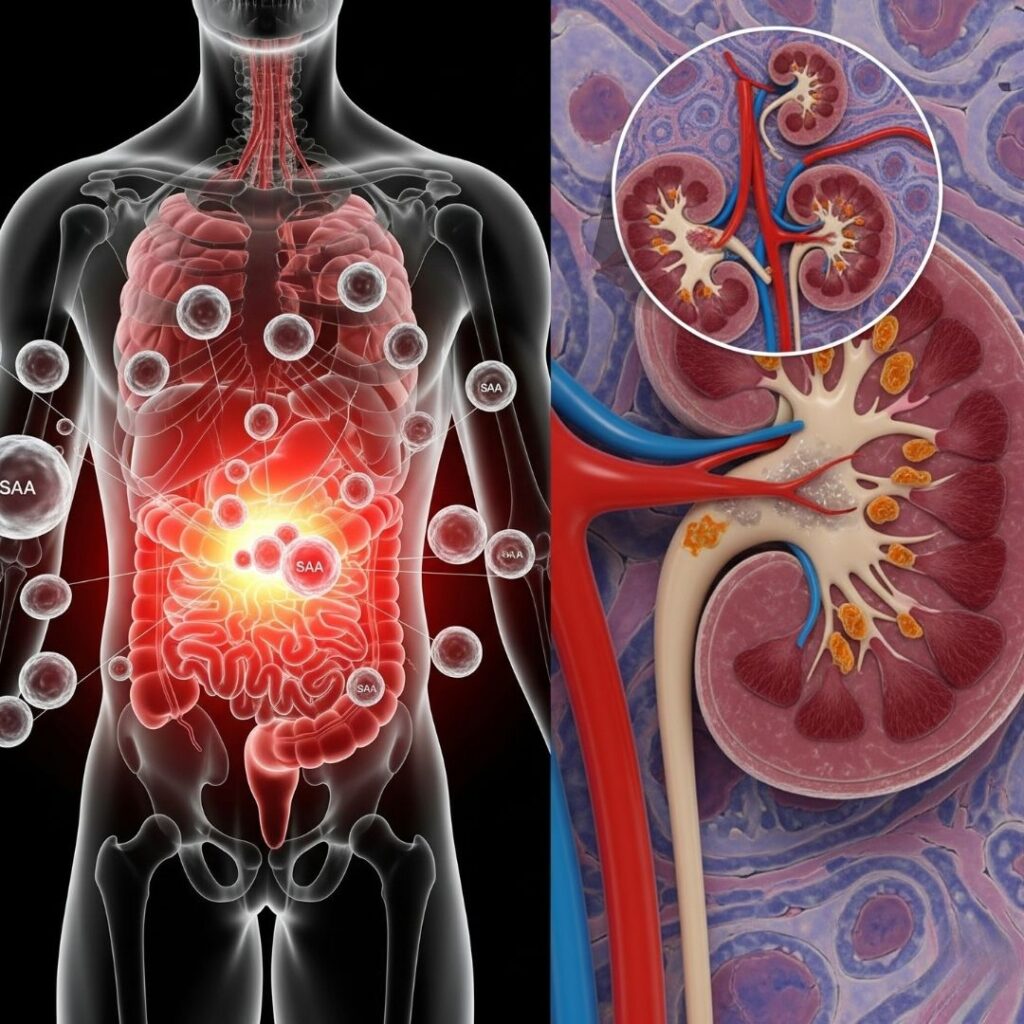Table of Contents
Introduction-Chronic Inflammation Cause AA Amyloidosis?

AA amyloidosis is a serious condition where there is accumulation of abnormally organized amyloid fibrils in various organs, particularly the kidneys. AA amyloidosis has a unique link with chronic inflammatory conditions. It is crucial to understand how chronic inflammation causes the development of AA amyloidosis for early diagnosis, control, and prevention.
This article explores the relationship between chronic inflammation and AA amyloidosis, specifically the role of Serum Amyloid A (SAA) protein, pathophysiological mechanisms, clinical relevance, and how inflammation control reduces risk.
Section 1: Understanding Amyloidosis
Amyloidosis is a group of diseases caused by the abnormal deposition of amyloid fibrils—misfolded proteins that deposit in organs and tissues. The deposits disrupt the normal function of organs and can lead to organ failure. AA amyloidosis is one of the systemic amyloidoses, i.e., multiple organs are involved.
Section 2: What Is AA Amyloidosis?
AA amyloidosis, or secondary amyloidosis, is caused by the deposition of a protein known as Serum Amyloid A (SAA) due to chronic inflammation. Recurrent elevation of SAA over a long period can lead to misfolding and deposition as amyloid fibrils in the organs, particularly the kidneys, liver, spleen, and gastrointestinal tract.
Section 3: Role of Chronic Inflammation
3.1 Causes of Chronic Inflammation
Chronic inflammation is caused by several chronic medical conditions, including:
- Rheumatoid arthritis (RA)
- Inflammatory bowel disease (IBD)
- Tuberculosis
- Chronic infections
- Familial Mediterranean Fever (FMF)
3.2 How Inflammation Increases SAA Levels
When the body is inflamed, acute-phase reactants such as SAA are synthesized by the liver in response to pro-inflammatory cytokines such as IL-1, IL-6, and TNF-alpha. During acute periods, SAA levels normalize once inflammation resolves. But with chronic inflammation, there are chronically elevated levels of SAA.
Section 4: The Pathogenesis of AA Amyloidosis
4.1 SAA Misfolding
When inflammation is prolonged, continued overproduction of SAA exceeds the body’s clearance capabilities. SAA fragments misfold and are deposited in insoluble fibrils.
4.2 Amyloid Deposition
These misfolded proteins circulate in the blood and deposit in tissues, forming extracellular amyloid plaques. Accumulation disrupts normal tissue architecture and function, most significantly in:
- Kidneys: Proteinuria and renal impairment
- Liver: Hepatomegaly
- Spleen: Inducing splenomegaly
- GI Tract: Malabsorption or bleeding
Section 5: Symptoms and Clinical Presentation
AA amyloidosis presentations depend on the organs affected:
- Kidney involvement: Edema, proteinuria, and eventually renal failure
- Gastrointestinal involvement: Diarrhea, weight loss, or bleeding
- Liver and spleen: Enlargement without excessive pain
It is difficult to diagnose at an early stage because symptoms are nonspecific and mimic other chronic illnesses.
Section 6: Diagnosis of AA Amyloidosis
6.1 Laboratory Tests
- Elevated SAA
- Proteinuria
- Reduced kidney function (elevated creatinine)
6.2 Biopsy and Histology
- Tissue biopsy Congo red staining (e.g., abdominal fat pad, kidney)
- Electron microscopy to confirm fibril structure
6.3 Imaging and Organ Function Tests
- Ultrasound to evaluate organ enlargement
- Kidney function tests
Section 7: Risk Factors
- Chronic autoimmune conditions
- Poorly controlled infections
- Familial predisposition (e.g., FMF mutations)
- Delays in the treatment of underlying inflammatory diseases
Section 8: Treatment and Management
8.1 Treating the Underlying Cause
The primary objective is to treat the underlying chronic inflammatory disorder:
- Rheumatoid arthritis: DMARDs and biologics
- IBD: Immunosuppressants and corticosteroids
- Infections: Chronic antibiotics
8.2 Reducing SAA Levels
With the control of inflammation, SAA levels can be decreased, preventing amyloid deposition.
8.3 Symptomatic Management
- Diuretics for edema
- Dialysis in advanced kidney failure
8.4 New Therapies
- Colchicine (especially in FMF)
- Anti-IL-6 drugs
- Experimental therapies for SAA amyloid fibrils
Section 9: Prevention Strategies
- Prompt diagnosis and aggressive treatment of chronic inflammatory diseases
- Regular monitoring of SAA in high-risk patients
- Genetic screening for inherited inflammatory diseases
Section 10: Living with AA Amyloidosis
Having AA amyloidosis requires a multidisciplinary approach:
- Regular follow-ups with rheumatologists, nephrologists, and internists
- Lifestyle and dietary changes to preserve liver and kidney function
- Psychological counseling for patients coping with chronic illness
Conclusion
AA amyloidosis is a treatable but serious disease if diagnosed early. Understanding how chronic inflammation results in the production of SAA and deposition of amyloid provides patient and clinician with the ability to intervene and prevent it. Treating the cause—inflammation—AA amyloidosis can be prevented or slowed in the majority of cases.
For anyone who must live with chronic inflammatory disease, monitoring SAA levels and maintaining inflammation in check is absolutely essential. Education, awareness, and proactive medical care are the best defense.
